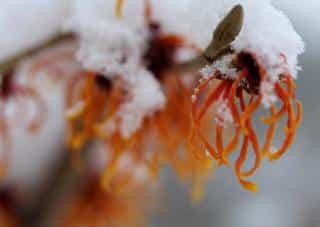

Witch-hazel is a dazzling shrub that blooms in winter, as early as January.
Witch-hazel facts, a summary
Name – Hamamelis
Family – Hamamelidaceae
Type – shrub
Height – 6 ½ to 16 feet (2 to 5 meters)
Exposure – full sun, part sun
Soil – rather rich
Foliage – deciduous
Flowering – January to March
Pruning and caring are practices that will enhance blooming and growth.
The planting of witch-hazel is preferably performed in fall to promote root development before winter.
For plants purchased in pots or containers, you can plant in other seasons than fall as long as both hot and cold spells are avoided.
If you’re lucky to have a terrace that can welcome a large pot, you’ll be able to grow witch-hazel in a container, because its slow growth makes it a good candidate to growing in such spaces.
Note also that witch hazel is particularly hardy to the cold, and so growing it in pots is all the more possible.
Caring for it is easy and its hardiness makes it almost invulnerable to most diseases as it does to insect attacks or parasites.
Watering is needed on a regular basis for witch-hazel when it’s hot and during the 2 first years after planting.
In winter, if it really doesn’t rain and the ground is dry, water when it isn’t freezing to ensure you’ll have proper blooming.
Since this tree appreciates acidic soil, feel free to pair it with heath plants with evergreen leafage such as camellia, azalea, rhododendron and heather.
It will also grow in perfect harmony with the Chinese fringe flower that also blooms in winter.

When the witch-hazel loses its leaves in fall, it then grows magnificent flowers with lemon-yellow colors at the beginning of January.
These flowers will then be replaced with superb deep green leaves.
Easy to care for and simple to grow, this shrub is particularly appealing when planted as a standalone, but it can also become part of a mixed hedge.
Witch-hazel is perfectly suited to growing in a small garden because of two things. First, its growth is very slow, and second, even when it has become a mature tree it is still quite small.
Lastly, let us note that it is quite invulnerable to diseases and parasites which makes it an easy tree to care for.
Witch-hazel is now an ingredient widely used in many pharmaceutical preparations thanks to its soothing properties on skin, especially dermatitis, and its influence on blood flow, varicose veins and hemorrhoids.
Mulch prepared from pine bark is a good idea.
The natural acidity this bark bequeaths favors witch-hazel growth and retains moisture.